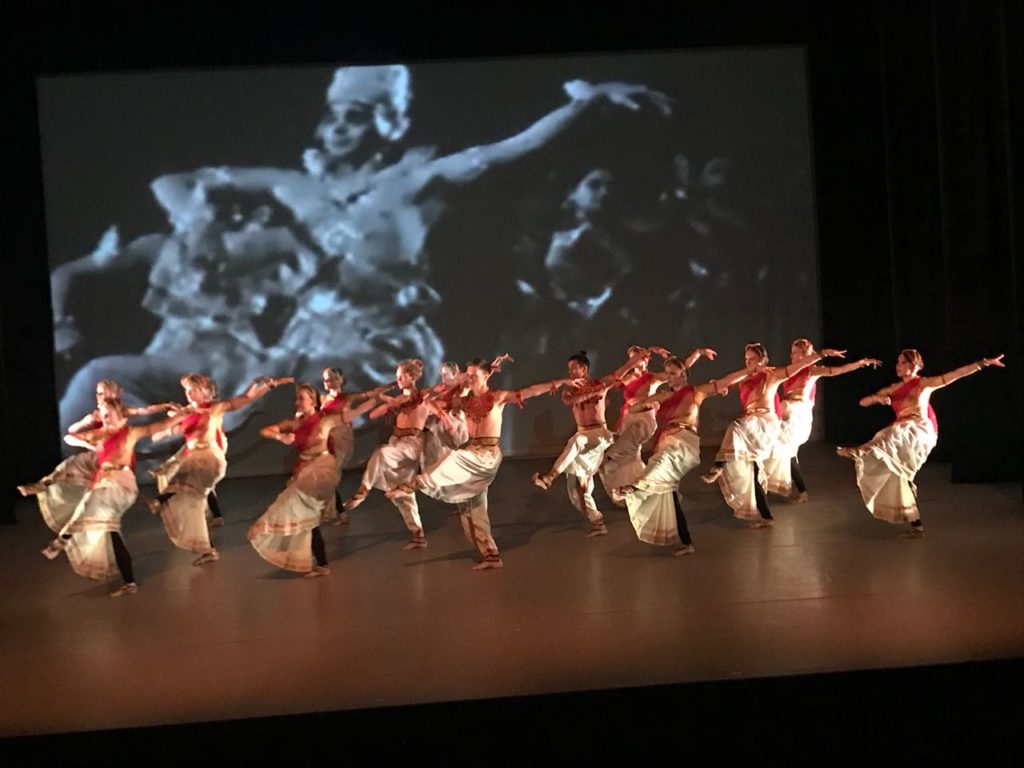Sacred Myths-Kartikeya, Himalaya and Apsara-3 segments restaged in the historical production.
The first piece is Kartikeya which was originally choreographed by Uday Shankar in the early 1940s. This dance was incorporated in his film Kalpana in 1948. References of the Dance can be seen in the film Kalpana (some links on you tube) where Uday Shankar performs this piece with his group of dancers.
The second and third segment are choreographies that are based on Uday Shankar’s Technique with reference to movements created by Uday Shankar.
Karthikeya
In Hindu mythology Kartikeya is the God of War. The Devas(Gods) are in retreat against the predatory force of the Asuras. It is for protection from the Asuras (personification of evil and greed) that Karthikeya is born. He is the promised son of Shiva who is born to defeat the Asuras and restore the cosmic balance. He is fierce and masculine- symbol of martial power and authority. Shankar takes the essence of this warlike god as we see in this dance. It is masculine and powerful which can be performed by both male and female dancers as seen in the popular version performed by him and his group in Kalpana. This composition captures the inner power in us to fight against evil and be triumphant. Fearlessness, valour, courage, positive energy and power put together makes Kartikeya, the epic dance piece that resonates with generations.
Himalaya
Indian mythology confers sacredness to the Himalayas where the Gods reside. Himalaya is also personified as the father of Parvati who gives her in marriage to Shiva. This union leads to the birth of Karthikeya who saves the world. Himalaya is strong yet tranquil. He bestows and sustains life through his waters and forests
The majestic Himalayas, holds a very special place in the sacred geography of Indian imagination. It is the source of the life-giving rivers of the sub-continent and is the space for practicing spirituality for millennia.
In this dance we imagine the Himalayas dancing in spiritual ecstasy. The dance opens with the setting sun and the rhythms of dusk. As the moon rises the Himalayas dance to the moonlight. It’s like the mountain range comes to life at night. There is twinkling moonlight broken occasionally by thunder or lightning. Whether it is calm or unsettled, the Himalayas dance through till the break of dawn and goes back to deep contemplation. It is day and the sparkling rivers flow, the birds sing and everything is serene. This composition shows two aspects of the mind-reposeful meditation and playful expression which balances life.
Apsara
This dance evokes the celestial dancers-the Apsaras, who perform for the gods. Celebrating the triumph of the Devas over the Asuras, this piece symbolises victory of the human mind over fear and material desire.
The cave paintings, temple carvings and statues of Apsaras and dancing figures found throughout India were always a source of inspiration for Uday Shankar. He used this material to create the base of his movements. “Apsara” is a homage to this heritage. Its movements are taken from Shankar’s inspirations around motifs found in traditional Indian Art. This choreography beautifully demonstrates layers of movement gestures that are part of Uday Shankar’s repertoire.











